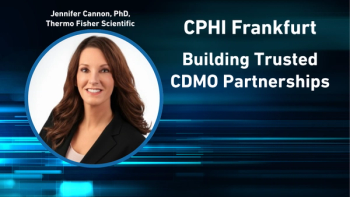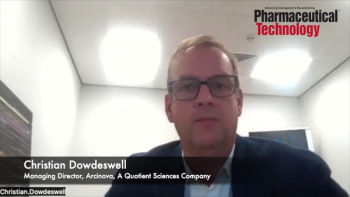
PTSM: Pharmaceutical Technology Sourcing and Management
- PTSM: Pharmaceutical Technology Sourcing and Management-05-06-2009
- Volume 5
- Issue 5
Project Management When Outsourcing with a Virtual Company
Best practices show the value of effective project management when outsourcing between a virtual pharmaceutical company and a contract manufacturing organization.
Outsourcing is an increasingly important tool for pharmaceutical companies as they seek to reduce internal capital costs and optimize resources for drug development and manufacturing. Although the elements of quality, speed, and reliability are common to any outsourced relationship, the expectations of the vendor by the sponsor company, project management, and project administration will vary depending on the partners involved. This situation is particularly true when a contract manufacturing organization (CMO) is working with a virtual pharmaceutical company. Although the degree of virtuality can vary, a virtual pharmaceutical company is typically a company developing drug candidates that does not have manufacturing capacity to produce clinical-trial materials or commercial quantities. Instead, these functions are outsourced to a third-party vendor.
Mark Mugerditchian, senior vice-president of manufacturing and product development with Sequel Pharmaceuticals (San Diego), and Stephen Boppart, senior account manager with DSM Pharma Chemicals, a unit of DSM Pharmaceutical Products (Parsippany, NJ), outline the skill sets, including project-management capabilities, required for a successful partnership between a virtual company and CMO. Mugerditchian was formerly senior vice-president of manufacturing and product development at NovaCardia, a pharmaceutical company specializing in developing cardiovascular treatments. Merck & Co. (Whitehouse Station, NJ) acquired NovaCardia in 2007. While at NovaCardia, Mugerditchian and his team partnered with DSM on an outsourcing project. The project involved the technical transfer of an existing drug-substance synthesis scheme, the development of the scheme to a very efficient and reproducible process, the production of that material for use in in-vitro and in-vivo studies, and the eventual production of a chemical entity for a commercial product.
Criteria in the supplier-selection processVendor capabilities. In its supplier-selection process, Mugerditchian points out that it is important to choose a vendor that can supply both clinical-trial materials and commercial quantities. “I have chosen to only work with companies that can take the drug candidate from the benchtop (i.e., lab-scale capacity) to the commercial marketplace because it does two very big things. It keeps the focus on whom is accountable for the delivery of results, and it avoids what I consider are unnecessary costs for the transfer of production from one site and company to another, which can usually be more than $1 million per project.”
Regulatory understanding. Regulatory competency is also a key element in the supplier-selection process. “With our company being a virtual company, each facet of the development was critical to the success of the overall project,” says Mugerditchian. “The supplier needs to understand the regulatory requirements of the work in the areas of the world that we intend to market our products, which typically includes the US, Europe, and Japan.” He emphasizes that in the outsourced relationship, the sponsor company, particularly a virtual pharmaceutical company, is seeking a vendor that has a deep understanding of chemical development and regulatory compliance, along with the capacity to resolve problems and concerns as they arise before they may even become obvious to the virtual company. “My objective is to use the systems in place at the vendor—the quality systems, regulatory systems, production systems, and management systems—and work within those systems unless there is something that absolutely needs to be changed to meet an extraordinary specific need.”
The interrelationship between the CMO and the sponsor company when the sponsor company is a virtual company is particularly important given the virtual company’s reliance on the CMO in providing manufacturing expertise. “Our company wants and needs to be expert on how to identify the main components of the drug-development program, namely what drug we need to study, what indication we need to research, the basic direction of the CMC [chemistry, manufacturing, and controls] plan, and how to move the project through the regulatory agencies,” says Mugerditchian. “We have decided to lead the product-development activities and to use our vendor as the expert in those areas.” Speaking of Sequel’s management team, Mugerditchian says, “We recognize that each of our senior management staff needs to be able to lead that function in our counterpart vendor. They need to have the experience and management temperament to do that, but each of the senior management staff also needs to be experts at leadership and knowing when to allow our vendors to ‘just do the work’ and when to step in to provide guidance. In this manner, we believe that a specific drug-development project has the greatest chance of success and will be completed in the minimum possible time in the most affordable manner. Most importantly, it focuses accountability of results on the CMO.”
Project management and adaptability. Successful project management with a given CMO and other vendors that may be participating in the project is critical. “The main challenge is getting each vendor to do their portion of the work in a sequence that will allow for the delivery of the product to the clinical site on time,” says Mugerditchian. “If the upstream vendors are late in delivering their product, it will almost always create a delay in the downstream delivery, which creates a delay in the delivery or the material to clinical sites.”
He explains that the issues behind these delays are typically not technical in nature, but more related to company systems and the sharing of information needed for each company to operate its respective systems. “For example, the drug-substance supplier may not have a policy of establishing an expiration date to early-phase clinical material, but the drug-product site may require an expiration date to receive the material into its system. If not caught early enough in the process, these system issues can cause delays in product release, which will create delays in product supply.”
The key way to mitigate these types of delays, says Mugerditchian, is to be able to identify potential problems in advance and to work collaboratively to resolve any issues quickly. “Sometimes, it involves working with a vendor to slightly alter their own internal policies to allow for whatever is needed to receive and release incoming materials,” he says. “It is often the case that vendors change their internal systems to take advantage of new knowledge gained by the interactions with their drug-development partners, and everyone benefits on the next project.”
Case analysis
In the case of the outsourcing project between DSM and NovaCardia, all the project’s objectives were met. “For the chemistry portion, we transferred the synthesis and produced our initial clinical trial materials on budget and according to schedule,” says Mugerditchian. The process was successfully scaled to initial commercial quantities on budget and according to schedule.
Best practices in project management. Mugerditchian points out that effective project management by its CMO, DSM, was a key factor behind the success of the project. “I attribute about 50% of our project success for the manner in which the project-management system was implemented.” DSM assigned a lead chemist at the early-stage of the project. That lead chemist was accountable for all the results to the customer but also internally to DSM. “This is the best way to set up a project-management process,” says Mugerditchian. “It allows the person to make the most positive difference to the customer. Because I don’t have a project-management person on my staff and because DSM’s main project person is also accountable for the technical outcomes of the project, we can work together directly because the lead chemist and I are the decision makers. This ensures that problems get resolved quickly and the project keeps moving forward with minimal to no delay. When the project moves to the commercial scale, the same relationship holds true for the project-management group at the new location.” He emphasizes that this approach is effective because it places all accountability for outcomes, both technical and business, with one point of contact in the CMO.
Effective communication is also critical for the CMO. “DSM was thrilled to work with Mr. Mugerditchian and his team on this project,” says Boppart. “The effective communication between our two organizations was fundamental to its success. DSM’s extensive knowledge of the regulatory and quality requirements gained over years of working with virtual pharma companies enabled us to suggest the next steps to NovaCardia as we moved through each clinical phase.”
The business value of a successful outsourcing relationship is underscored by the eventual sale of NovaCardia to Merck. “Our project with NovaCardia was purchased by Merck after Merck had done a thorough evaluation of the entire development program, including the CMC portion of the development plan,” says Mugerditchian.
Looking forward
The success of the companies’ project is leading to other work between the partners. The former management team at NovaCardia is now at Sequel Pharmaceuticals and is working with DSM on an outsourcing project for a drug candidate that is in clinical testing for an intravenous and oral form of the drug. Sequel, which specializes in developing cardiovascular treatments, is also evaluating other compounds to begin development work to in-license from other companies to supplement its product pipeline.
Articles in this issue
over 16 years ago
Public's View of FDA Shows Agency Needs to Improveover 16 years ago
Contract Organizations are the Sell of the SeasonNewsletter
Get the essential updates shaping the future of pharma manufacturing and compliance—subscribe today to Pharmaceutical Technology and never miss a breakthrough.





